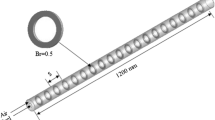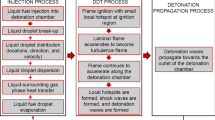Abstract
The objective of the present analysis is to investigate the effect of gaseous hydrocarbon fuels, such as Octane C8H18, Hexane C6H14, and Pentane C5H12 on the cyclic combustion process in an obstructed channel of the pulse detonation engine. Three-dimensional reactive Navier-Stokes equations are used to simulate the combustion mechanism of stoichiometric hydrocarbon fuels along with a one-step reaction model. The fuel is injected at atmospheric pressure and temperature and is ignited with pre-heated air. The investigation shows that initially a high-temperature combustion wave propagates with the local speed of sound; it creates turbulence after colliding with obstacles, resulting in an increase to supersonic flame speeds. Therefore, different values of the combustion flame propagation speed, combustion efficiency and impulse per unit area are obtained for these fuels. The detonation speed in the hexane-air mixture is about 5.8% lower than the detonation speed predicted by the NASA CEA400 code. However, it is observed that the octane fuel reduces the deflagration-to-detonation transition run-up distance as compared to other fuels.
Similar content being viewed by others
References
Y. G. Phylippov, V. R. Dushin, V. F. Nikitin, et al., “Fluid Mechanics of Pulse Detonation Thrusters,” Acta Astronaut 76, 115–126 (2012).
N. N. Smirnov, V. B. Betelin, V. F. Nikitin, et al., “Detonation Engine Fed by Acetylene-Oxygen Mixture,” Acta Astronaut 104, 134–146 (2014).
N. N. Smirnov and V. F. Nikitin, “Modeling and Simulation of Hydrogen Combustion in Engines,” Int. J. Hydrogen Energy 39 (2), 1122–1136 (2014).
N. N. Smirnov, V. B. Betelin, R. M. Shagaliev, et al., “Hydrogen Fuel Rocket Engines Simulation Using LOGOS Code,” Int. J. Hydrogen Energy 39, 10748–10756 (2014).
W. Lu, W. Fan, K. Wang, et al., “Operation of a Liquid-Fueled and Valveless Pulse Detonation Rocket Engine at High Frequency,” Proc. Combust. Inst 36, 2657–2664 (2017).
J. Hoke and R. Bradley, “Impact of DDT Mechanism, Combustion Wave Speed, Temperature, and Charge Quality on Pulsed-Detonation Engine Performance,” in Proc. 43rd AIAA Aerospace Sciences Meeting and Exhibit. (2005), p. 1342.
K. Rouser, P. King, F. Schauer, et al., “Experimental Performance Evaluation of a Turbine Driven by Pulsed Detonations,” in Proc. 51st Aerospace Sciences Meeting (2013), p. 1212.
E. Mallard and H. L. Le Chatelier, “Sur la Vitesse de Propagation de L'innammation Dans les Melanges Gazeux Explosifs,” Compt. Rend. Acad. Sci. Paris 93, 145–148 (1881).
M. Berthelot and P. Vieille, “Sur la Vitesse de Propagation des Phenomenes Explosifs Dans les Gaz,” Compt. Rend. Acad. Sci. Paris 93, 18–22 (1881).
V. A. Mikhelson, “On the Normal Velocity of Ignition of Explosive Gas Mixtures,” Uch. Zap. Imper. Mosk. Univ., Otd. Fiz.-Mat 10, 1–92 (1893).
D. L. Chapman, “On the Role of Explosion in Gases,” Philos. Mag 47, 90 (1899).
E. Jouguet, “On the Propagation of Chemical Reactions in Gases,” J. Math 1, 347 (1905).
A. C. Egerton, O. A. Saunders, A. H. Lefebvre, and N. P. W. Moore, “Some Observations by Schlieren Technique of the Propagation of Flame in a Closed Vessel,” in Proc. 4th Symp. (Int.) on Combustion (Williams and Wilkins, Baltimore, 1953). pp. 396–402.
A. K. Oppenheim and R. A. Stern, “On the Development of Gaseous Detonation e Analysis of Wave Phenomena,” in Proc. 7th Symp. (Int.) on Combustion (Butterworths, London, 1959). pp. 837–850.
G. D. Salamandra, T. V. Bezhenova, and I. M. Naboko, “Formation of Detonation Wave during Combustion of Gas in Combustion Tube,” in Proc. 7th Symp. (Int.) on Combustion (Butterworths, London, 1959), pp. 851–855.
V. A. Popov, “On the Pre-Detonation Period of Flame Propagation,” in Proc. 7th Symp. (Int.) on Combustion (Butterworths, London, 1959), pp. 799–806.
P. A. Urtiew and A. K. Oppenheim, “Experimental Observations of the Transition to Detonation in an Explosive Gas,” Proc. Roy. Soc. A 295, 13–28 (1966).
J. H. Lee, “Dynamic Parameters of Gaseous Detonations,” Ann. Rev. Fluid Mech 16, 311–336 (1984).
G. Ciccarelli, C. Johansen, and M. Parravani, “The Role of Shock-Flame Interactions on Flame Acceleration in an Obstacle Laden Channel,” Combust. Flame 157 (11), 2125–2136 (2010).
O. Peraldi, R. Knystautas, and J. H. S. Lee, “Criteria for Transition to Detonation in Tubes,” Proc. Combust. Inst 21, 1629–1637 (1986).
M. Kellenberger and G. Ciccarelli, “Propagation Mechanisms of Supersonic Combustion Waves,” Proc. Combust. Inst 35, 2109–2116 (2015).
A. Teodorczyk, J. H. Lee, and R. Knystautas, “Propagation Mechanism of Quasi-Detonations,” Proc. Combust. Inst 22, 1723–1731 (1988).
T. Heifrich, F. Schauer, R. Bradley, and J. Hoke, “Ignition and Detonation Characteristics of Hydrogen and Hydrocarbon Fuels in a PDE,” AFRL-RZ-WP-TP-2007-243 (1988).
N. N. Smirnov, V. F. Nikitin, V. R. Dushin, et al., “Combustion Onset in Non-Uniform Dispersed Mixtures,” Acta Astronaut 115, 94–101 (2015).
M. Kuznetsov, G. Ciccarelli, S. Dorofeev, et al, “DDT in Methane-Air Mixtures,” Shock Waves 12, 215–220 (2002).
A. V. Gaathaug, K. Vaagsaether, and D. Bjerketvedt, “Experimental and Numerical Investigation of DDT in Hydrogen-Air Behind a Single Obstacle,” Int. J. Hydrogen Energy 37, 17606–17615 (2012).
F. Gnani, H. Zare-Behtash, C. White, and K. Kontis, “Effect of Back-Pressure Forcing on Shock Train Structures in Rectangular Channels,” Acta Astronaut 145, 471–481 (2018).
N. Alam, K. K. Sharma, and K. M. Pandey, “Numerical Investigation of Combustion Phenomena in Pulse Detonation Engine with Different Fuels,” AIP Conf. Proc, 020015 (1966).
E. Dzieminska and A. K. Hayashi, “Auto-Ignition and DDT Driven by Shock Wave-Boundary Layer Interaction in Oxyhydrogen Mixture,” Int. J. Hydrogen Energy 38, 4185–4193 (2013).
J. Warnatz, U. Maas, and R. W. Dibble, Combustion: Physical and Chemical Fundamentals, Modeling and Simulations, Experiments, Pollutant Formation (Springer, Berlin-Heidelberg, 2001).
J. O. Hirschfelder, C. F. Gurtiss, and R. B. Bird, Molecular Theory of Gases and Liquids (Wiley, New York, 1964).
H. Wei, Y. Shang, C. Chen, et al., “One Dimensional Numerical Study on Pressure Wave-Flame Interaction and Flame Acceleration under Engine-Relevant Conditions,” Int. J. Hydrogen Energy 40, 4874–4883 (2015).
https://www.encyclopediaofmath.org/index.php/Accu-mulation_of_errors.
B. Kehlet and A. Logg, “A Posteriori Error Analysis of Round-off Errors in the Numerical Solution of Ordinary Differential Equations,” Numer. Algor 76, 191–210 (2017).
S. Gordon and B. J. McBride, Computer Program for Calculation of Complex Chemical Equilibrium Compositions and Applications (I): Analysis (NASA, Washington, 1994).
L. Jie, Z. Longxi, W. Zhiwu, et al., “Thrust Measurement Method Verification and Analytical Studies on a Liquid-Fueled Pulse Detonation Engine,” Chin. J. Aeronaut 27 (3), 497–504 (2014).
J. Card, D. Rival, and G. Ciccarelli, “DDT in Fuel-Air Mixtures at Elevated Temperatures and Pressures,” Shock Waves 14 (3), 167–173 (2005).
E. Wintenberger, J. M. Austin, M. Cooper, et al., “An Analytical Model for the Impulse of a Single-Cycle Pulse Detonation Engine,” in Proc. 37th AIAA/ASME/SAE/ASEE Joint Prop. Conf. Exhibition, 2001.
K. Kailasanath, G. Patnaik, and C. Li, “The Flow Field and Performance of Pulse Detonation Engines,” Proc. Combust. Inst 29, 2855–2862 (2002).
Author information
Authors and Affiliations
Corresponding author
Additional information
Original Russian Text © N. Alam, K.K. Sharma, K.M. Pandey.
Rights and permissions
About this article
Cite this article
Alam, N., Sharma, K.K. & Pandey, K.M. Effects of Various Compositions of the Fuel—Air Mixture on the Pulse Detonation Engine Performance. Combust Explos Shock Waves 55, 708–717 (2019). https://doi.org/10.1134/S0010508219060121
Received:
Revised:
Accepted:
Published:
Issue Date:
DOI: https://doi.org/10.1134/S0010508219060121




